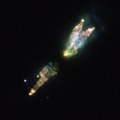Податотека:Westbrook Nebula.tif

Големина на овој JPG-преглед на оваа TIF-податотека: 600 × 600 пиксели. Други разделности: 240 × 240 пиксели | 480 × 480 пиксели | 1.000 × 1.000 пиксели.
Изворна податотека (1.000 × 1.000 пиксели, големина: 1,8 МБ, MIME-тип: image/tiff)
Историја на податотеката
Стиснете на датум/време за да ја видите податотеката како изгледала тогаш.
| Датум/време | Минијатура | Димензии | Корисник | Коментар | |
|---|---|---|---|---|---|
| тековна | 14:44, 9 март 2011 |  | 1.000 × 1.000 (1,8 МБ) | Jmencisom | {{Information |Description ={{en|1=The strange and irregular bundle of jets and clouds in this curious image from the NASA/ESA Hubble Space Telescope is the result of a burst of activity late in the life of a star. As its core runs out of nuclear fuel, |
Употреба на податотеката
Податотекава се користи во следниве 2 страници:
Глобална употреба на податотеката
Оваа податотека ја користат и следниве викија:
- Употреба на ar.wikipedia.org
- Употреба на arz.wikipedia.org
- Употреба на de.wikipedia.org
- Употреба на en.wikipedia.org
- Употреба на en.wikiversity.org
- Употреба на fa.wikipedia.org
- Употреба на fr.wikipedia.org
- Употреба на it.wikipedia.org
- Употреба на ja.wikipedia.org
- Употреба на nl.wikipedia.org
- Употреба на pl.wikipedia.org
- Употреба на ru.wikipedia.org
- Употреба на sk.wikipedia.org
- Употреба на tr.wikipedia.org
- Употреба на uk.wikipedia.org
- Употреба на vi.wikipedia.org
- Употреба на www.wikidata.org
- Употреба на zh.wikipedia.org

